The Arrival
“Turn here!” I yelled as my dad inadvertently whipped past a tiny, dusty road.
Screeeech.
“This is a street?” my dad said as he turned. “Wow, this is definitely out there.”
As we drove down the sinuous single lane road, snippets of songs crackled over the radio like scratchy vinyl, oscillating between head bobbing Beyoncé and sonorous, old-school baritone country.
“All my single ladies. All my single ladies… She’d been drinking way too hard one night she’d been drinking way too long… All my single ladies. All my single ladies.” My dad tapped his fingers on his knee with one hand as he navigated our yacht-sized Toyota Sequoia down the back roads, leaves haphazardly whizzing past our windshield like drunk birds. I clutched the pieces of white paper he’d printed a couple days before — MapQuest directions that he insisted we use.
Do people even use MapQuest anymore? I wondered. But I didn’t argue; after all, my dad had volunteered to drive the almost two hours south of St. Louis into the middle of nowhere to drink beer. When we hit a fork in the road that MapQuest had nonchalantly skipped, I finally whipped out my iPhone. Turns out modern technology may be one of the only ways to find a brewery that ironically invites you to trek into the bucolic hinterlands of Southern Illinois, turn off your electronic devices, and escape urbanity by sitting outside and drinking beer made with ingredients often picked a stone’s throw from your picnic table.
At Scratch Brewing in Ava, Illinois, everything is made from scratch. And, I mean literally everything. From the beers — which use unique foraged ingredients such as hyssop, sweet clover, goldenseal, blackberries, and even tomatoes (just to name a few) — to every building on the property, as well as the hand painted walls in the bathroom from local painter Brett Douglas Hunter and the local-artisan crafted flight trays from Rick Henson, a regular who commutes past the brewery every day.
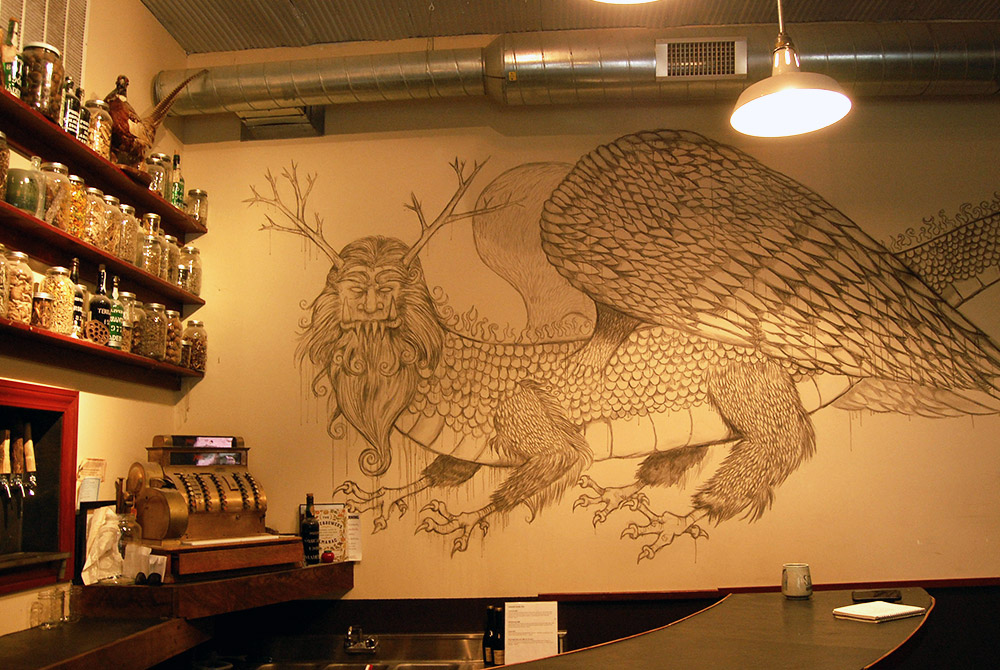
Something immediately became clear: Scratch goes way beyond brewing beer. When my dad and I finally pulled into the sandy parking lot and stepped onto the brewery’s five acre plot of forest, we entered into a special kind of fermenting ecosystem. As I made my way to the brewery’s front door, I walked across stones laid by co-owner Aaron Kleidon, brushing past piles of oak leaves co-owner Marika Josephson had hand picked and steeped to make Dead Leaves and Carrots, the beer I would later drink. Once inside, I sipped on roggenbier, sours, and saisons all made with the same house-cultured sourdough yeast that fed the homemade bread, pretzels, and pizza dough. All the while, I stared at a forest and garden brimming with the very ingredients that had found their way into my glass.
“If you’re coming here and eating the food and drinking the beers, you’re in this loop of one random house cultured bacteria, which is really beautiful,” said David Wright, the Taproom Manager at Scratch. “It’s all connected in that beer. It’s pretty wild.” I watched him feed wood from a nearby Amish community into the brewery’s outdoor pizza oven, coaxing the kiln towards 750 degrees for the expectant hungry (and thirsty) crowd that would show up when the taproom opened in about an hour.
With acres of trees only steps away from us, “wild” seemed to describe Scratch perfectly. The very ethos of the brewery was life, a huffing and puffing of yeast and bacteria and strange, beautiful ingredients.
And, like all living and breathing organisms, Scratch’s journey started with a humble first step into uncharted territory. Teetering and a bit unsteady, the nascent brewery got its start on the very earth I found in the parking lot — on a very special piece of land.
Beginning from Scratch
Scratch Brewing sprouted from the brains of three avid homebrewers tinkering about in the early 2000s in Southern Illinois — a place that, at the time, lacked any depth of craft beer culture.
Marika Josephson, Aaron Kleidon, and Ryan Tockstein (who recently left the project to work at Bohemian Brewery in Midvale, UT) met through their shared hobby.
“When we moved out here, there was virtually no craft beer,” said Josephson, who’d followed her boyfriend to Carbondale when he’d started a PhD program at Southern Illinois University. “The liquor stores had Fat Tire and Sam Adams, if anything. It was a very desolate landscape. I decided to take up homebrewing. I thought, ‘If I can’t find it here, I’ll just make it.’”
At the time, Josephson was finishing a dissertation for her own PhD program in Philosophy from New York University, which gave her a good deal of mobility as well as the need for a hobby. Although homebrewing was new to her, beer itself had always been a big part of her life. Originally from San Diego, Josephson watched Stone Brewing and Pizza Port grow up as her dad, a drinker, dabbled in homebrewing.
“I remember there was always a carboy in our garage,” said Josephson.
Kleidon, on the other hand, originally grew up in Southern Illinois, and had only recently returned from stints at a ski resort and airport in Colorado. Moving back to be closer to his friends and family, he connected with Josephson through her blog, which chronicled her experiences making soda and liquor. He called and asked if she wanted to learn how to make root beer.
Meanwhile, Tockstein discovered beer while working at a grocery store in college. He started by trying a 12-pack of George Killian’s Irish Red and kept experimenting. With a background in physics, it wasn’t long before Tockstein started brewing his own beer.
All three crossed paths when a bottle shop opened in Carbondale, quickly becoming the watering hole for area brewers. After many conversations, the friendly trio decided to morph their brewing infatuation into a business. In 2011, they set out to find a location, looking at a couple spaces that each fell through for one reason or another.
Coincidentally, Kleidon’s family owned land outside of nearby Ava — a town of 70 residents at the confluence of Southern Illinois farmland and the Shawnee National Forest. With no other viable options, the three asked Kleidon’s parents if they could use their land to start a brewery.
Like most of the brewery’s operations, the rest fell together. The team rented the flattest five acres, cleared a portion, and began building.
“It truly has been a family affair from the beginning,” said Josephson. “I call his family our unsung heroes. Aaron’s dad was here every single day with us at the start, hanging drywall and building every little detail. In fact, he was here just yesterday raising the sink in the kitchen.”
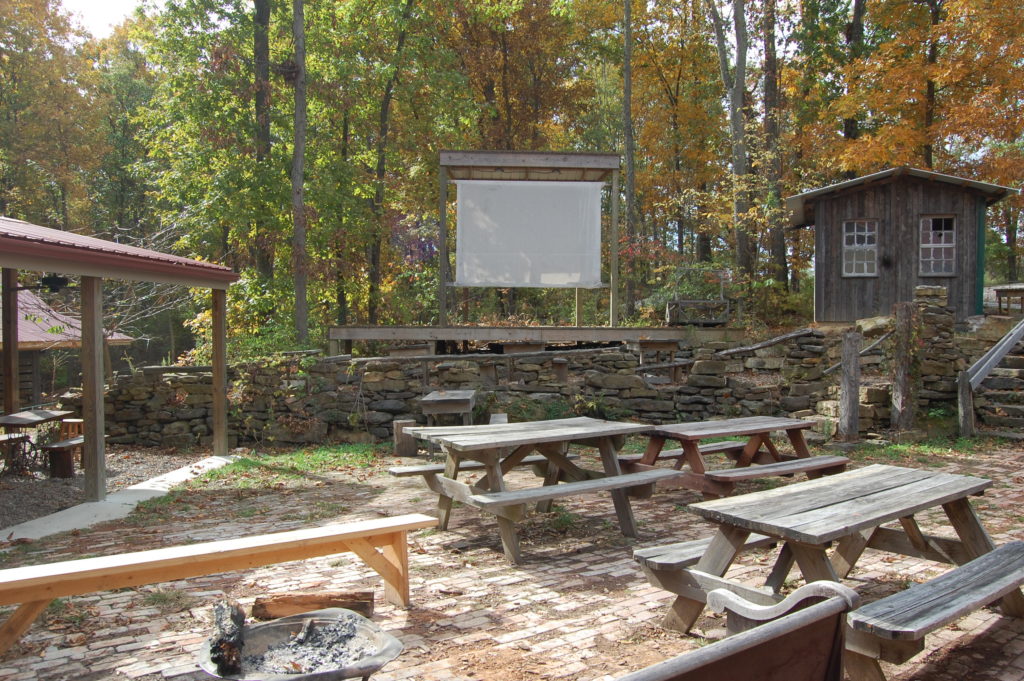
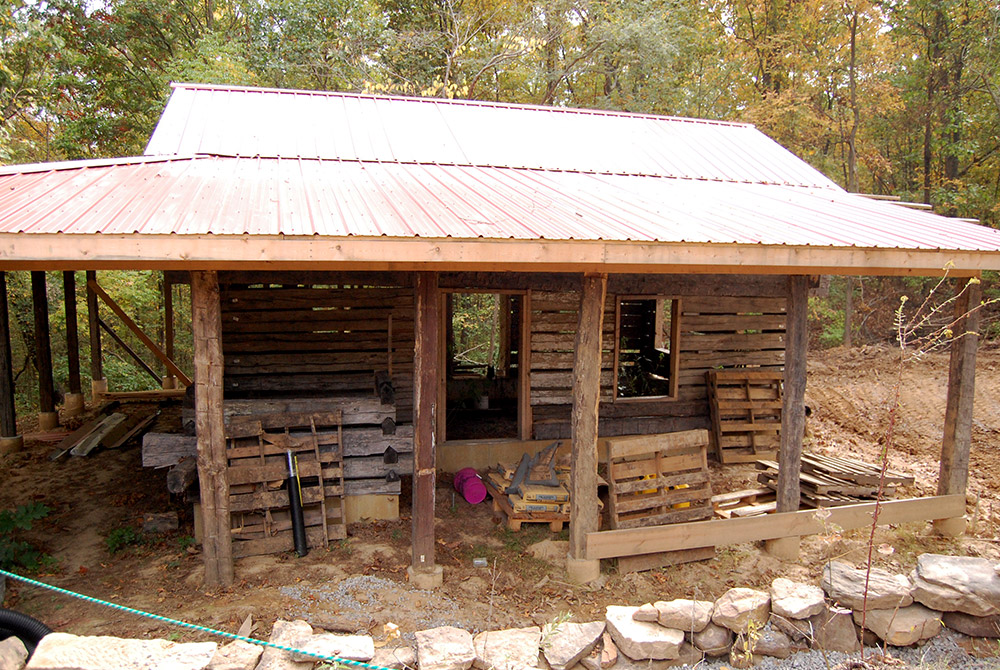
Over the course of five years, what started as a single structure has morphed at the hands of Kleidon and his father. Like 10-year-olds with a set of Legos, the Kleidons have built Scratch brick by brick, erecting a pavilion, stage, screen for movies, cellar for bottle conditioning, parking lot, and even a cabin — one of Kleidon’s favorite obsessions.
“Aaron’s definitely the builder here,” said Wright as we stood behind the brewery and chatted about Scratch’s evolution. “He wants to do everything, create everything, and make everything…Here, you’re interacting with a space that’s handmade and can’t be like anything you’ve ever seen before. Everything in this place is a work of art made with time, effort, love, and attention. There wasn’t anything here [at the start]. They built this from scratch.”
Hence the name — Scratch Brewing.
“It was Aaron’s idea,” said Josephson. “He called me and Ryan one day and said, ‘Got it!’ We all sat and mulled it over and felt like it was the right way to go. We never had twenty or forty different names to figure from. Actually, I don’t even remember having one or two. It didn’t really seem right until it struck Aaron.”
That spark of inspiration has woven its way intuitively into everything at Scratch, from the buildings to the beer. The more time I spent walking around the grounds with Wright, the more he seemed to reverently revert back to that very word, intimating a connection to a larger purpose.
“It seems silly, but there’s a huge amount of work that goes into just producing pizzas with tomato sauce grown with tomatoes from our farm, basil harvested from the garden, pizza dough that we shape with our house sourdough culture, and bread that we bake each week,” he said. “Everything is made from Scratch. That’s about as easy as I can say it.”
Scratching the Surface
Sheepishly, I snuck a glance at my cell phone for the first time since I’d set foot into Scratch’s territory.
Noon.
I wandered past a pair of muddy boots and through a screen door to the now open taproom, where a crowd already hovered around the half-moon bar. Beneath shelves brimming with jars of herbs and foraged treasures, Wright slung 5oz pours to a thirsty horde that was eager to try beers they couldn’t find anywhere else. Despite being two hours from the closest city of note (St. Louis), Scratch has thrived, attracting close to 500 curious drinkers each weekend.
Building the brewery by hand in the middle of nowhere had its benefits and disadvantages.
“It allowed for us to start up on a shoestring budget that we would never have been able to make work in any kind of metro area,” said Josephson. On the flip side of that coin, being located in a very rural and remote area meant that Scratch needed to learn how to organically attract customers.
“We’re a destination,” said Dylan Smith, who started working at Scratch five months ago. “We’re literally in the woods. This is the joke: everyone can’t believe they found this place. If it weren’t for maps, no one would ever know where we are.”
To put Scratch on the metaphorical and literal map, Josephson, Kleidon, and Tockstein started out on an aggressive festival circuit, bringing with them granite rocks painted with the names of the different ingredients in their beers: Basil Ale, for instance, or Roasted Dandelion Root Stout. The trio quickly realized that their new brewery’s success depended on letting people try their beer, but also marketing the uniqueness of kooky and quirky ingredients.
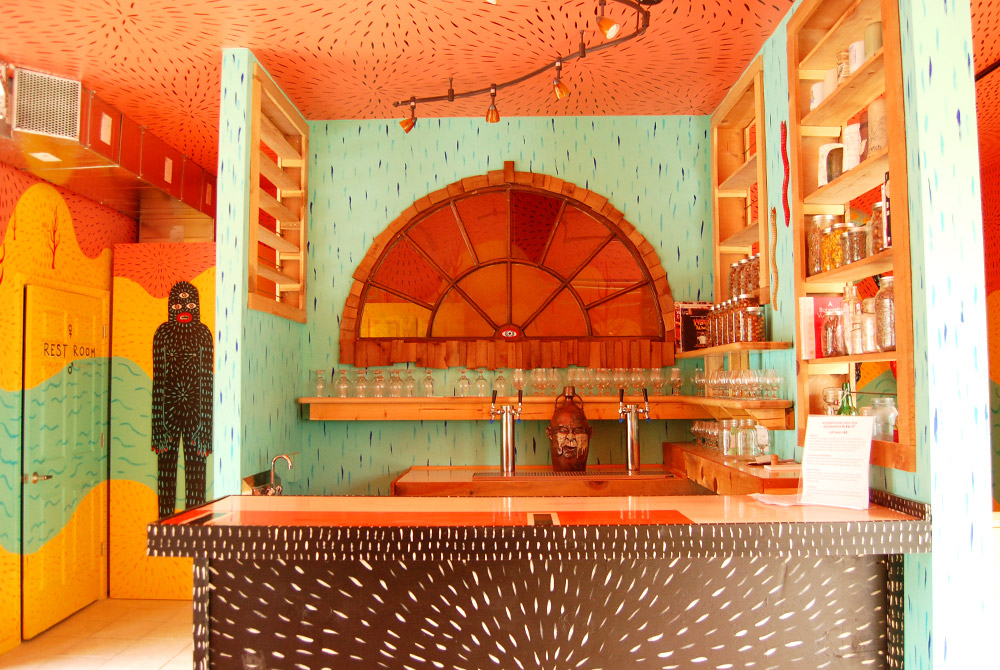
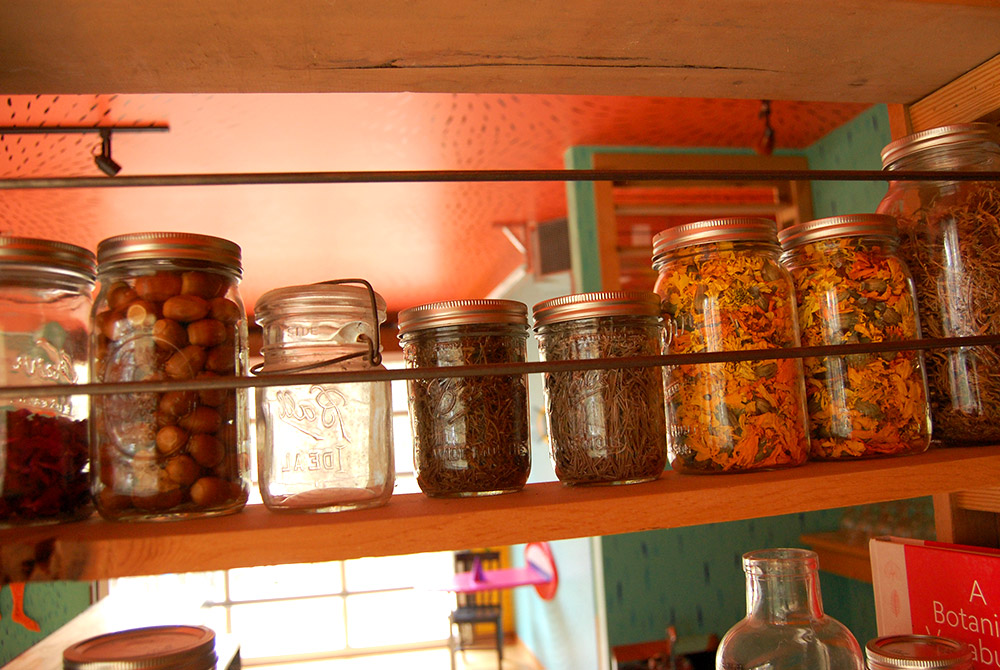
“We did make a conscious decision not to advertise when we opened,” said Josephson. “We wanted everything to spread by word of mouth.” It wasn’t long before news reached St. Louis, and even Chicago — a six hour drive away.
“Scratch is unique and innovative,” said Mike Schultz, who drove six hours from Rockford, Illinois to visit. His father-in-law, Ed Van Awken, lives only five miles up the road, so whenever Schultz comes down to see him, Scratch is a regular stop. “They’re always pushing the limits of what beer is and what you can do with interesting ingredients.” Now, when Schulz leaves Ava, he loads up on whatever cases of beer Scratch has available. Last time, it was a Strawberry Rhubarb sour; on the day I visited, Schultz left with two cases of Blackberry Lavender, a bottle-conditioned sour made with locally-grown blackberries and lavender from the garden. “Whenever I bring Scratch to a beer share up north, it’s always the hit of the party,” Schultz continued. “Everyone always asks where it’s from and wants to know more about the brewery. It’s a great conversation piece.”
Regular customers like Schultz have organically spread the Scratch gospel, and people have listened. Whether through MapQuest directions or smartphone GPS (or, like me and my dad, a combination of both ), people found their way to Scratch.
A Niche to Scratch
In the surrounding forest, farms, and gardens, Scratch forages for nearly 50 percent of the ingredients that go into their beer. Depending on the beer, that number can be even higher. Josephson picked the oak and hickory leaves from the parking lot to add to their Dead Leaves and Carrots ale. The smoker I passed on the steps down to the patio smoked the coffee beans from Dark Matter in Chicago for the Sweet Clover and Smoked Coffee brown ale. For Mumm, a dark sour beer inspired by an ancient recipe Josephson found while flipping through a copy of Sacred and Herbal Healing Beers — the same book that inspired Butch at Earth Eagle Brewings, Scratch’s Northeastern counterpart — Josephson plucked lavender, rosemary, chocolate mint, lemon thyme, sage, and basil from right outside their front door.
“I found a recipe that said, ‘Hey, take a couple dozen different herbs, throw it into a beer at the beginning of the boil for 60 minutes, let it sit for a while, and see how it tastes.’ I did just that and I liked the results.” Over time, the beer has evolved as Josephson experiments with different herbs, yeasts and styles.
Mumm is a beer the mimics the entire brewing process at Scratch, where a recipe idea can come from an ingredient growing in the garden or simply from Kleidon taking a walk through the back of the property and smelling something unusual.
“We’ll identify it, and if we’ve never used it before, we’ll make a tea with it to see how it comes out when steeped or boiled,” said Josephson. “Like a jazz session, we like to riff on other people’s ideas of what they’re tasting and what that ingredients could be combined with in terms of different malts, hops, or herbs we have growing.”
Growing and foraging ingredients for beer means that the brewery functions on an ingredient’s clock — not any specific brewing schedule.
“We always wanted the brewery to be about the plants that we were using,” said Josephson. “The very nature of the life of plants is that they’re not available all year round. We wanted to be using them when they were at their peak, whenever that may be.”
Following this wacky vein of inspiration, Josephson, and Kleidon refused to nail themselves down to a single type, style or flagship beer. During my most recent visit, the chalkboard menu read more like the Peterson Field Guides to edible wild plants than a brewery tap list: Sour Hyssop, Sweet Clover and Smoked Coffee, Goldenseal, Dead Leaves and Carrots, Rosemary Schwarzbier, Marzen, Mumms, Lemon Balm Roggenbier, Tomato Saison.
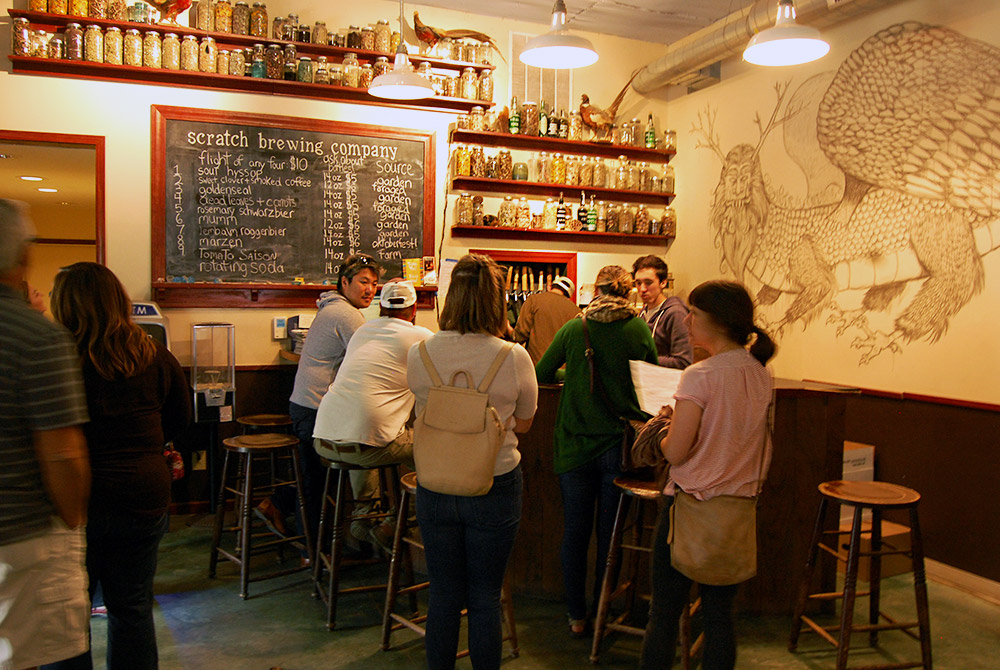
“We’re trying to get away from calling beers by styles and just calling them what they are,” said Wright.
Keeping the names simple means Scratch can highlight not only the unique ingredients in the beer, but also those products they can’t directly source from their property. To maintain a hyper local loop, Scratch uses water from Lake Kincaid about 10 miles away and malt from Sugar Creek Malt Co. in Lebanon, Indiana. The goal is to bring customers as close to the source of their beer as possible.
“We spent a lot of time creating an atmosphere here that is welcoming and that makes you feel a part of the woods,” said Josephson. “We hope that whole experience is symbiotic. We think it’s important for people to experience beer where it comes from.”
For that reason, Scratch mostly forgoes distribution, selling 95 percent of their beer from their taproom. This production model — light on distribution and heavy on tap sales — not only cuts down on what would be astronomical keg costs, but also encourages people to make the pilgrimage to Ava to drink from their compendium of rare and unusual beers.
“You can only get their stuff here,” said Jake Stygar, a fan who’d first come to the brewery as part of a beer tour with his wife. The duo loved the beer so much the first time they’d come back for more. “You can’t just go to a local grocery store and pick it up,” said Stygar. They’re planning on making their expedition to Scratch a part of a yearly tradition.
For others, Scratch isn’t just about the constantly rotating selection of fantastic beer.
“I love the rustic appeal of being out in the country,” said Dave Choisser, who drove a hair shy of an hour and half with his family to Scratch to celebrate his birthday. “There’s no other noise except what’s around you.”
From Scratch to Finish
From the beginning Josephson and Kleidon have always been experimenting whether using new ingredients or even playing around with a variety of brewing methods and vessels. For a collaboration called Stein Beer with the Austin, Texas-based brewery Jester King, they constructed an oak puncheon with a false bottom made out of willow branches woven together with string. Using this contraption, the two breweries ensured the stein beer never touched modern stainless steel. To boil the beer Scratch and Jester King used a German technique of throwing hot rocks into the wort. Kleidon had to gather a special type of granite from Missouri that could sustain high temperatures without exploding. To mash into the oak barrel, Josephson and Kleidon placed a layer of those granite rocks underneath the branches to hold them in the bottom of the puncheon followed by another layer of hot granite, water, and grain. By building a spigot in the bottom of the barrel they could transfer the wort out quite efficiently.
Collaborations have been a successful way for Scratch to flex their creative muscle. Accidental circumstances morphed into a hilarious brewing project still on the horizon with Arizona Wilderness. During Perennial’s Midwest Belgian Beer Fest last July, Patrick Ware and Jonathan Buford, co-owners of Arizona Wilderness visited Scratch to put together a beer. Kleidon rented a pontoon and the crew set out onto Lake Kincaid to forage for ingredients. After anchoring onto an island in the middle of the lake, everyone got out and scrounged for things to bring back to the brewery. When the group returned to their pontoon, they found it floating 100 yards away. “Everyone had to swim back to the boat with a cooler filled with foraged ingredients,” Wright chuckled. “We’re [tentatively and] playfully calling the beer Edible Island.”
These brewing projects have reinforced Scratch’s roots, but often times in the past the demands to constantly innovate, forage, brew, and run a taproom between three people (and eventually two when Tockstein left) have kept Scratch grounded. Bringing on Wright to manage the taproom in early January, Josephson and Kleidon have finally been able to take a step back from the day-to-day operations.
Additionally, last year Scratch hired two farmers, Kris Pirmann and Adriane Koontz, to help out with the foraging and in the kitchen.
Josephson and Kleidon met the married farmers through a mutual friend, but had been buying produce from their Southern Illinois farm for years. When Pirmann and Koontz returned from a year-long sabbatical running a farm farther north, Josephson and Kleidon figured they could benefit from the farmers’ skills. Pirmann works full-time tending the garden, pickling vegetables, and searching out ingredients, while Koontz bakes all of the bread.
Now with their hands slightly untied, the co-owners can dedicate even more time to experimenting and expanding. Flush with ideas, Josephson mentioned one in particular. She hopes to build and tinker with a kuurna, a Finnish mashing vessel made out of a hollow log.
Beyond brewing the duo have finally developed plans to increase their production levels. In 2014, the year that Scratch opened, the brewery produced 200 BBLs. In 2015, they produced 240. In 2016, between 250 and 300 BBLS. With a now dedicated following and word continuing to spread, Scratch has reached full capacity.
“We’re definitely crammed in right now,” said Josephson. On their current system, Scratch can only crank out 7 BBLs tops per batch of beer.
At the back of the property sits a pit of dirt and short wood walls, outlining the beginnings of a multi-purpose building. Eventually, the space will become a new structure to house a 7 to 8 BBL mash tun. Instead of four turns, Scratch will need just one turn in the mash tun for a single brew. They’ll also be able to double their fermentation vessels from 7 BBLs to between 15 and 16 BBLs.
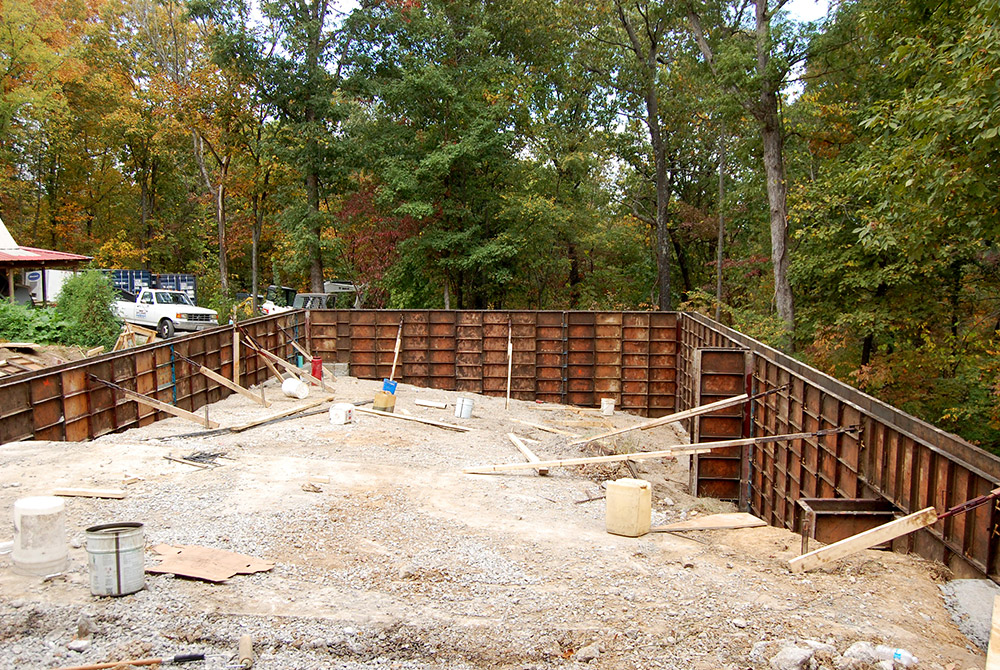
With more space, more equipment, and more man (and woman) power than ever the future at Scratch – much like the forest around the property – continues to sprout and grow.
Opening the Door, Closing the Loop
I finished my last sip of Dead Leaves and Carrots and picked up a brown paper bag stuffed with a leftover loaf of rye bread. Ruefully, I headed for the door. I could have stayed inside of Scratch’s whimsical world for at least a couple more hours, but I needed to start the two hour trek back to the city.
“Don’t forget to say hi to the goats on your way out,” Wright said, before turning back to his phone conversation. “Have you gotten to Mudline road yet? We’re before Mudline. Okay, you’re way past us.” I pushed open the door. “Have you hit 127? As you passed through Ava, was the main part of town on the right hand side? I think you’re going South…” Wright’s voice trailed off as I made for the parking lot, confident that once the person on the other line found this place — whether by way of printed off MapQuest directions, GPS enabled GoogleMaps, or coaching on the phone — they’d never want to leave.
